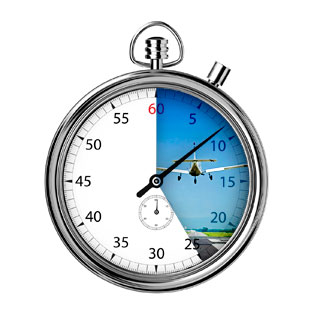Technique: Lunchtime currency
Something you can do in 30 minutes

Three takeoffs and three landings, startup to shutdown, in 30 minutes. That was the objective.
As a renter pilot, I was finding it a challenge to stay current in three different aircraft models. To maintain rental currency, the flight school where I rented aircraft required pilots to fly each model of aircraft rented at least once every 60 days, otherwise a few trips around the pattern with an instructor would be in order. Although I was renting Cessnas and a Piper regularly, at the time the school still had a Socata Tobago and a couple of Tampicos on the line, and I wanted to stay current in them (a flight in either renewed currency in both)—while they weren’t speed demons, they were comfortable rides, and the visibility offered by their expansive canopies and the positioning of their front seats ahead of the wing made them the perfect choice for offering first flights, or any time I just wanted to take friends up for a ride.
Lunchtime seemed like a good time to log flights that would maintain rental currency. Could I shoot three landings and shut down in half an hour? Here’s what a typical lunch-hour currency flight evolved to look like:
- 12:05 p.m. Leave the office and walk to the flight school. (Seems like it’s always tough to get out of the office on time.)
- 12:09 p.m. Arrive at front counter and dispatch aircraft; review maintenance status and check the clipboard for any discrepancies. (It’s only fair to acknowledge that walking to the school—and, indeed, the entire lunchtime currency concept—may only be practical if you’re close to the airport at noon. The AOPA office’s location on Maryland’s Frederick Municipal Airport makes this easy.)
- 12:12 p.m. Begin preflight.
- 12:21 p.m. Start engine and taxi to active runway—most often Runway 23, it’s the longest possible taxi from the ramp.
- 12:26 p.m. Arrive at the run-up area and conduct runup; complete preflight checklist.
- 12:30 p.m. Clear runway, taxi out, and begin takeoff roll.
- 12:36 p.m. First touch and go; this one’s behind a slower trainer that decided on the base leg to make a full-stop landing.
- 12:43 p.m. Second touch and go, with an extended downwind to accommodate an arriving turboprop.
- 12:48 p.m. Full-stop landing after having the pattern to myself, allowing a nice, tight arrival.
- 12:52 p.m. Shut down after taxiing back to the ramp.
- 1:01 p.m. Walk back to the office after tying down the airplane and paying my bill.
- 1:05 p.m. Return to office.
Out of the office for an hour even, flying for 31 minutes, logging 0.5 on the Hobbs—not bad.
What about lunch, you ask? While I might be better off skipping it, a sandwich from the company cafeteria fills the bill, and I eat it at my desk.
Lunchtime often seems to be a good time for pattern work at my airport; there’s seldom closed traffic in the pattern, although you can encounter transient operations anytime. My logbooks show that I hit the 0.5-hour mark more often than not. Sometimes, if there was lots of traffic—or one other pilot flying an especially wide pattern—the mission took 0.6 or 0.7 on the Hobbs. A couple of times I completed my objective in 0.4 hours, although I believe those flights benefitted more from rounding or a previous pilot’s misinterpretation of the Hobbs meter.
While that seemed like productive pattern time, a look further back in my logbooks found many flights that tallied 10 to as many as 13 landings in an hour of Hobbs time. These were at the smaller, much less busy Triple W Airpark in Fuquay-Varina, North Carolina, where I first learned to fly. Triple W featured much shorter taxis and, generally, a much tighter pattern. (While I have not been back there in many years, I understand that thanks in part to a devastating flood, flight operations there are much reduced from the late 1980s.)
It’s important to note that the lunchtime currency challenge is not a race, but a focus. It’s not a substitute for the proficiency that comes with regular flying. Don’t watch the clock while the engine’s turning; instead, look at the time after shutdown, when you log the Hobbs numbers. After all, they’re the driver here.
These days I’m not attempting to maintain rental currency in multiple aircraft models, so I have not employed the lunchtime currency drill at Frederick since an air traffic control tower opened here earlier this year. Maybe I should give it a try—just to see if it’s still an option in a towered environment.
Email [email protected]


